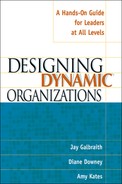0%
17Chapters
0-1Hours read
0kTotal Words
Book Description
Which business structures are best suited to the unpredictable 21st century? How can a company, division, or department reconfigure itself with minimum disruption and maximum impact? Every executive grapples with problems of restructuring--and most need hands-on guidance to solve them. This eye-opening book shows business leaders at all levels how to examine their choices by leading them systematically through these fundamental questions: * Should we restructure to meet our strategic goals? * What are the best structural options to achieve our success? * What lateral processes are necessary to support the new structure? * How do we staff the restructured organization to optimize results? Based on Galbraith's world-renowned approach, this guide includes examples and worksheets that pilot readers through the essential steps of organizational design.Book Description
Which business structures are best suited to the unpredictable 21st century? How can a company, division, or department reconfigure itself with minimum disruption and maximum impact? Every executive grapples with problems of restructuring--and most need hands-on guidance to solve them. This eye-opening book shows business leaders at all levels how to examine their choices by leading them systematically through these fundamental questions: * Should we restructure to meet our strategic goals? * What are the best structural options to achieve our success? * What lateral processes are necessary to support the new structure? * How do we staff the restructured organization to optimize results? Based on Galbraith's world-renowned approach, this guide includes examples and worksheets that pilot readers through the essential steps of organizational design.Table of Contents
- Cover Page
- Title Page
- Copyright Page
- Contents
- Preface
- Acknowledgments
- Chapter One - Getting Started
- Chapter Two - Determining the Design Framework
- Chapter Three - Designing the Structure
- Chapter Four - Processes and Lateral Capability
- Chapter Five - Defining and Rewarding Success
- Chapter Six - People Practices
- Chapter Seven - Implementation
- Conclusion
- Glossary of Terms
- Bibliography
- Index
